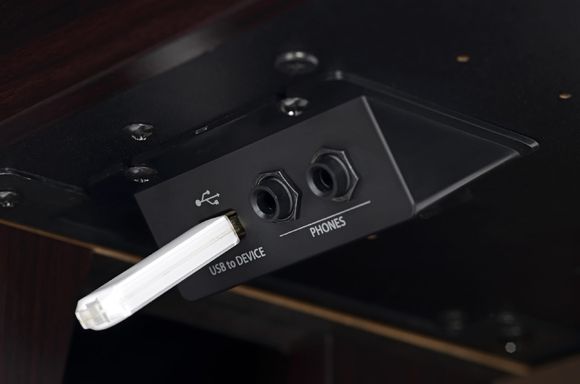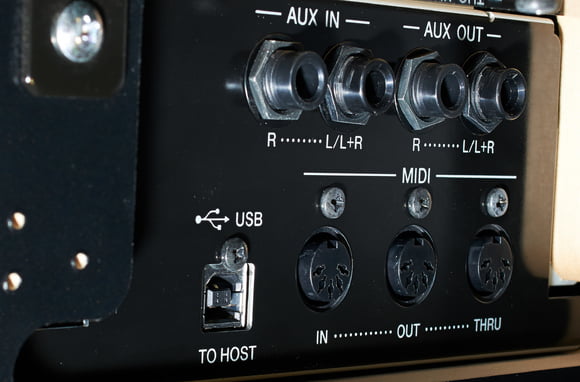7. Additional Functions
Some digital pianos offer many features in addition to high quality keyboard and other authentic sounds. Some have a so-called arranger, with which you can combine keyboard and digital piano. Allowing your playing to be accompanied by different styles and rhythms as well as other instruments on a keyboard, without having to worry about weighted keys. Other features include:
Recorder
A function would be, for example, the internal recording of the self-played pieces, which can be edited with various options on a computer / tablet, etc.
Sounds – a comprehensvie selection of sounds from various keyboard instruments.
In addition to normal and grand pianos, other sounds is also possible. Some manufacturers offer over 1600 including guitar, organs, drums etc.
WLAN-Connection
Use instrument apps to broaden your musical horizons. Some manufacturers offer the option of connecting your smartphone or tablet via Wi-Fi or cable. So you can edit a recording or use learning function with the right app.
Microfone-Input / Vocalist
Makes it possible to connect a vocal microphone, which can be controlled via the digital piano. The microphone signal can be controlled by a vocalist function. For example, devices which have this built in allow the voice to be duplicated or populated with effects. With the press of a button, the player / singer can sing like a complete choir or create a reverberation effect like in a church.
Touch Display
In the field of musical instruments the focus is on simple operation, today there are instruments with touch displays which allow you to open a grand piano flap to be opened or closed digitally. Simple and intuitive operation is guaranteed as with tablets or smartphones.
Metronome
Almost all digital pianos now have a metronome, which provides a steady pace to play by. For practicing pieces, the metronome is an important tool. Each piece of music has a certain tempo and time signature that must be respected when playing. The metronome helps by evenly setting the pace.
Connections
All connections are ultimately for the purpose of connecting the instrument and a computer. Of course there are many more options with the help of MIDI and USB.

Connector panel with USB to device and headphone connectors
- USB to device
Here, for example, a USB stick can be connected to the instrument and recorded pieces can be stored. - USB to host
This connection enables data exchange between a PC and instrument. You can access the internal memory of the instrument with it as well. - MIDI:
To connect an instrument to the computer via Midi (in the absence of a USB to host connection), a MIDI USB interface is required. The instrument and PC use this to communicate with one another.

Rear panel with audio output, MIDI interface and USB to host
Headphone Input
Most digital pianos have 2 inputs for headphones. This allows for playing as a pair or just listening along. Additionally you can practice at any time of the day or night without disturbing your neighbors. Inserting headphones also mutes the instrument automatically.
Transpose
Most digital pianos (but not all!) have a transposition function, which allows the pitch of the instrument to be shifted by a certain interval at the push of a button. Allowing you to play in a different key even if the notes are the same. Useful when accompanying B or Eb instruments (eg clarinet, saxophone, alto recorder ...). Transposing instruments can allow you to play in treble clef, for example, without having to worry about the fact that what's played isn't what's noted. The person playing the digital piano can make sure you're playing in the same key with this function as well. The only thing to watch out for is what the transpose function is currently set to as you may use the wrong pitch with the wrong song. Especially common if you switch between multiple instruments.
With this and many other features, a digital piano can turn into an entertainment device or a teaching aid with a guide function. It can help with composition by displaying notes and connecting with a PC. And of course it can serve as a replacement for a real piano.
Pedals
Almost all digital pianos have the ability to connect pedals or are delivered with a triple pedal bar.
Each pedal has its own separate function and can be connected differently to each instrument and used however you want. But the standard functions are:
- Right Pedal
In a "real" piano it would lift dampers off the strings, allowing the sound to continue after the key has been released. Each sound keeps sounding after it is keyed. On a grand piano the pedal has a range, allowing sounds to be more or less dampened. So if you press the pedal only half way down, it's called half pedaling. High quality digital pianos also offer this function. - Middle Pedal
Unlike most pianos, the middle pedal on a digital piano does not function as a felt between hammers and strings (moderator), rather it simulates the middle pedal of a grand piano. The tone hold pedal must be pressed while playing a key and only that sound is held, all other played notes are damped normally. On a grand piano this worked by preventing the damper that has already been raised from falling back onto the string and thus dampening it. All digital pianos with built-in 3-way pedals have this function as the middle pedal. - Left Pedal
The left pedal of pianos caused the hammers to come closer to the strings, on a grand piano this moves the entire playing mechanism. But that's not possible on a digital piano. Instead a digital piano simulates this as authentically as possible and, with the help of changes in the computing speed, produces the desired effect.




